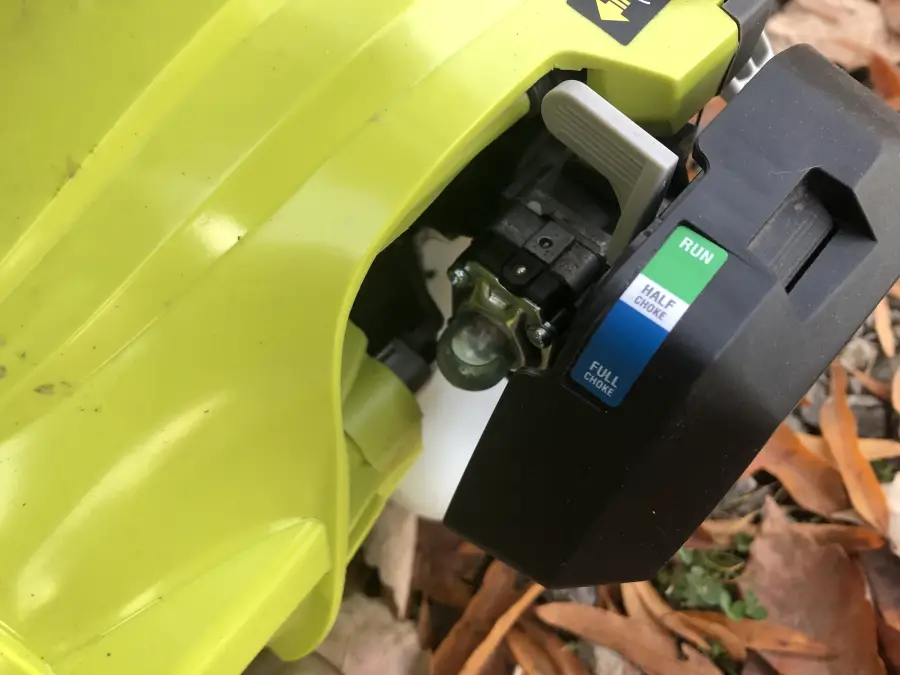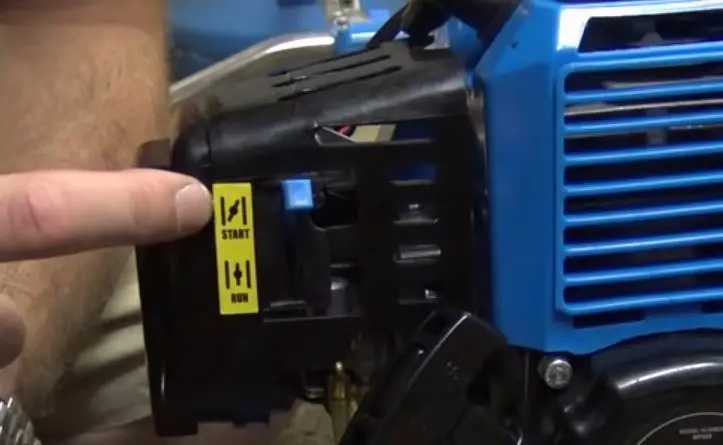If you find it difficult to identify the “on” and “off” positions of a choke switch, you are not alone. Sometimes, it could take a light turning on to be able to tell if a switch is turned on or off, but in the case of a choke without a bulb, what would the indicator be? Which symbol on a choke is on or off?
The choke symbol is in the on position restricting air into the engine when the lever points to an angled or horizontal line. This can also be designated by the words ‘Choke’, ‘Full Choke’, or ‘Start’. When the choke is off or disengaged the lever points to a vertical line or the word ‘Run’.
There is a lot more to know about how a choke works and what these symbols or words mean. The concept is not hard to grasp, so read through the rest of this article and you will know all you need to know about small engine chokes.

Contents
What Position Is ‘Choke On’?
It can be confusing for those not very familiar with mower or trimmer engines to know what the use of a choke is for and what the positions mean. Understanding the simple operation of a choke can help to know what the position of the choke lever does.
First of all, why is it even called a choke? The choke function on your lawn equipment (or any other electrical equipment) is used to control the air that enters the cylinders and mixes with the fuel.
In clearer terms, when the choke is on, the airflow is restricted and when it is off, air can enter freely. This means that the status of the choke on your lawn equipment can determine how well it functions when in use.
I will get into this in more depth later on, but essentially turning on the choke keeps more of the fuel fumes in the engine and restricts most of the airflow that would dilute the fuel vapors. This concentrated fuel environment helps with starting and warming up the engine.
Now that we have an idea of how the choke functions, it is ideal to know how to identify the “on” and “off” position of the choke on your lawn equipment.
How Do You Know If The Choke Is On Or Off?

In most cases, the choke is a small lever or switch on one side of the lawn equipment. When the lever is pushed up or forward to a diagonal or horizontal line, the choke comes on. When the choke is on, the carburetor gets blocked by a plate-like obstacle.
At this point, you can say that the system is “choked” and when the lever is pulled down (or backward) to a vertical line, the choke goes off. The obstacle is removed and air can flow into the vessel where it gets combined with fuel.
If all you get is a (mostly red) switch to control the choke, you just need to rehearse these two points:
- One: the “I” indicates that the choke is on or the airflow is restricted.
- Two: the “O” indicates that the choke has been turned off.
If your lawn equipment suddenly goes off or sounds like it’s struggling to stay on, you may want to check the choke lever before calling a technician. If the air-fuel ratio is imbalanced, the engine would struggle to function properly so you always want to have your choke lever at the right spot when using the equipment.
Another note: many times in the middle of a long job the engine would start to sputter on me, making me adjust the choke and suspect something could be wrong with the fuel to air ratio. Though I was normally right about the air ratio in the engine, it was normally that I had let it run out of fuel.
Embarrassing at the time, but funny now.
One other side point that is interesting to note: Researchers are always looking for better ways to use fuels and engine design. For now, chokes are the main way to control air and fuel entering a carburetor, but in the future this may not be needed.
In a technical paper published on SAE.org, engineers and researchers alike are finding ways to make engine starting easier on users and more energy efficient. Today, you can even see automatic chokes on many higher end models from most brands.
Though, these come with their own problems, as most innovations do.
Here are some other articles for you from LawncareGrandpa.com…
- 7 Reasons Why a Riding Mower Won’t Move Forward or Reverse
- Can You Mow Your Lawn On Sunday? Check Before Starting!
- What Is Spring Clean Up For Lawn Crews And Homeowners?
Is It Bad To Leave The Choke On?
This question could go three ways:
- “Is it good to leave the choke in the on position during starting?
- “Is it good to leave the choke on after turning on the equipment?”
- “Is it good to leave the choke on after using the lawn equipment?”
The answer to any question that asks about leaving a choke on is definitely, no. When starting the choke is only used to help prime the engine. When operating a mower or other small engine tool, running with the choke on indicates or can cause problems. Chokes should be turned off for storage.
Leaving The Choke In The On Position During Starting
When the choke is on, fuel combustion is optimized for use.
In other words, the air-fuel ratio is controlled and the carburetor can function adequately. This indicates that it is not only good but important to turn on the choke before using the equipment in question.
This position helps with starting and warming up the engine.
Starting Tip: What I normally do to start a small engine with a choke is to hit the priming bulb 5 to 10 times depending on the equipment with the choke on full (—). I then pull the cord or turn the ignition switch (key) until the engine sputters. Then I reduce the choke to half ( / )and start the engine. After a few seconds of warming, I turn off the choke ( | ) to let the engine run normally with optimal air intake.
Now let’s look at the problems it could cause or indicate when leaving the choke on during operation is attempted.
Leaving The Choke On During Operation
Now, when in full operation, you may want to pull down (or back) the choke lever a little. As long as the choke remains on, more fuel would be used and if you don’t mind using up a little more fuel to mow, you could leave it on throughout the operation.
However, this may not be ideal for mowing procedures that last up to an hour or longer. Keeping the choke on for that long could not only cause the engine to use up more fuel, but it could also increase pollution and cause the system to heat up more than necessary.
That being said, this is not the intended or optimal use of a choke. Most normally operating engines will sputter and smoke on full choke once started and warmed up. There will also be decreased power and movement on mowers that are properly tuned and working on extended full choke use.
There are two reasons that your mower or other equipment may only run on full choke”
- There is some sort of blockage in fuel lines, the fuel filter, or air filter reducing the amount of fuel reaching the carburetor.
- The fuel used has an octane mixture that is less than optimal due to the presence of water or other additives.
Finding and fixing these issue can increase fuel efficiency and operation. For the purposes of our discussion here, it can also cure the problem causing your mower, blower, or weedeater only running on full choke.
Do You Leave The Choke In The On Position When Storing?
After the lawn has been mowed to your satisfaction, what do you do? Turn off the equipment and leave the choke on so you don’t have to worry about it the next time?
The simple answer to this is “turn off the choke”.
The purpose of the choke is to warm the system when it is in operation and when the lawn equipment is turned off, it is advisable to turn off the choke as well.
Even leaving the choke in the ‘half’ position is not a good idea when storing. In some cases, the choke lever may be pulled down halfway after starting with it in the full position the mowing equipment has warmed up to reduce fuel combustion.
Understanding The Role Of The Choke In A Lawn Mower
The choke feature on your lawn equipment is designed to practically choke the carburetor and restrict the airflow. This is to allow the right amount of air and fuel to mix during the operation of the equipment. As long as the choke is on, fuel enters the vessel, and the longer it is left on, the more fuel is used in the procedure.
If the fuel supply is too much, it affects the operation of the lawn mower. You might think that since the lawn mower operates on fuel, giving it more fuel supply should be the way to go.
This brings back a memory of when I got my first lawn mower. I was sure that the higher the concentration in the fuel supply determined the speed of the lawn mower. I was wrong.
My actions caused for some rough running of the mower engine. It can even in rare cases cause perminent damage to the carburetor. When the fuel supply is overwhelming, the carburetor can develop leaks.
If the carburetor leaks without you knowing, think of the possible damage it could cause. This is why you have to know the role of a choke in your lawn mower.
The same goes for air flow in the carburetor. If the air supply is cut off, it could also affect the engine from functioning the way it was made to.
If you notice any irregularities with your lawn mower’s idle or normal operating sound and feel after ruling out choke positioning, I recommend that you get your small engine mechanic to take a quick look at it.
When the choke lever is pushed up, the choke is on and when it is pulled down, it goes off. You could also pull the lever halfway down during operation or halfway up at the beginning of the operation. The colder the engine, the more fuel it needs, and thus, the higher the lever should go.
If you have determined that none of these positions cure sputtering or stalling, it is time to look elsewhere for the solution.
The Final Touches On The Choke On Symbol…
To sum up our original question:
The choke on symbol for most small engines looks like a horizontal ( — ) or diagonal ( / ) line. It also can simply say ‘Choke’, ‘Full Choke’, or ‘Start’.
The off symbol for most small engine chokes is represented by a vertical line ( | ) or the word ‘Run’.
Hopefully you have learned something here. If you liked this article, here are some others you will enjoy…
- Kawasaki Engine Problems: Diagnoses, Fixes, And Tips
- Why Is My John Deere Engine Surging? (Answered)
- What To Do If Your PTO Won’t Engage (Answered)
Resources
https://www.wikihow.life/Start-a-Push-Lawn-Mower
https://faq-law.com/what-does-the-choke-symbol-mean-on-a-honda-lawn-mower/
https://support.troybilt.com/s/article/1947-1?language=en_US
